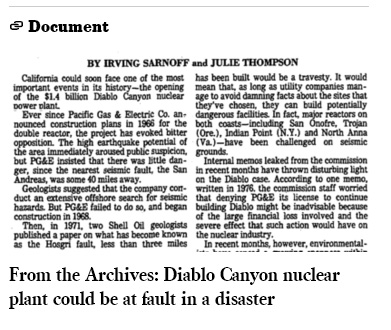Author Archive
Feds sue to block acquisition of Dallas radioactive waste company
The U.S. Justice Department is suing to block the acquisition of Dallas-based Waste Control Specialists, which wants to expand the nuclear waste dump it operates in West Texas.
NOV. 18, 2016
By Kiah Collier
Texas Tribune
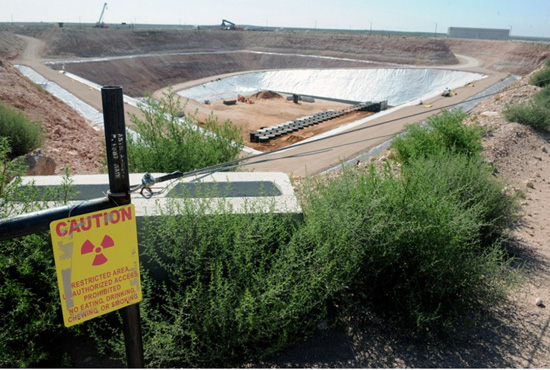
An overhead view in 2012 of Waste Control Specialists’ low-level radioactive waste storage facilities near Andrews, Texas. Photo: David Bowser
The U.S. Justice Department is suing to block a Salt Lake City-based company’s acquisition of Waste Control Specialists, the Dallas-based company that wants to expand the nuclear waste dump it operates in West Texas.
If the $367 million merger with proposed buyer EnergySolutions goes through, it would "combine the two most significant competitors for the disposal of low level radioactive waste (LLRW) available to commercial customers in 36 states, the District of Columbia and Puerto Rico," the Justice Department said in a statement announcing the civil antitrust lawsuit.
That merger would "deny commercial generators of LLRW – from universities and hospitals working on life-saving treatments to nuclear facilities producing 20 percent of the electricity in the United States – the benefits of vigorous competition that has led to significantly lower prices, better service and innovation in recent years."
"Since opening its LLRW disposal facility in 2012, Waste Control Specialists has provided EnergySolutions the only real competition it has ever faced," Assistant Attorney General Renata Hesse in the statement, which noted that "billions of dollars are set to be awarded in the coming years."
EnergySolutions said it would "vigorously defend" the pending acquisition, noting in a statement that "there are numerous disposal sites for LLRW waste operated by the competitors of the two companies."
A spokesman for Waste Control Specialists did not respond to an emailed request for comment.
In April, the company submitted an application to the Nuclear Regulatory Commission seeking to expand the radioactive waste dump it operates in Andrews County. It was seeking to store tens of thousands of metric tons of spent nuclear reactor fuel that is currently scattered across the country. (Federal policymakers have been trying to figure out what to do with the high-level radioactive waste for decades.)
The commission has requested additional information from the company in June that it has yet to provide. But the commission is still moving forward with its review and is seeking public comment on how the project could impact the environment, including endangered species, significant cultural resources and sensitive areas, along with increases in traffic and noise and dust from construction.
"We cannot proceed with the technical safety review until WCS adequately addresses our request for supplemental information, but we do have the information we need to begin the environmental scoping process now," said Mark Lombard, who heads the commission’s division of spent fuel management, in a statement this week. "WCS will bear the cost of staff time devoted to the environmental review, even if we are unable to docket the application in its current form."
Written comments can be submitted at www.regulations.gov; via email to WCS_CISF_EIS@nrc.gov; or by mail to Cindy Bladey, Office of Administration, Mail Stop: OWFN- 12 H08, U.S. Nuclear Regulatory Commission, Washington, DC 20555-0001.
Read more of the Tribune’s related coverage:
- Anti-nuclear groups seize on missing information in license application from Waste Control Specialists, which says it’s normal to add information to a complex, voluminous application.
- The company operating a low-level nuclear waste dump in West Texas applied for a license to begin accepting highly radioactive spent nuclear fuel.
This document contains copyrighted material whose use has not been specifically authorized by the copyright owner. SEED Coalition is making this article available in our efforts to advance understanding of ecological sustainability, human rights, economic democracy and social justice issues. We believe that this constitutes a "fair use" of the copyrighted material as provided for in section 107 of the US Copyright Law. If you wish to use this copyrighted material for purposes of your own that go beyond "fair use", you must obtain permission from the copyright owner.
WCS: Environmental study amid application process makes sense
Saturday, November 5, 2016
By Trevor Hawes
The Midland Reporter
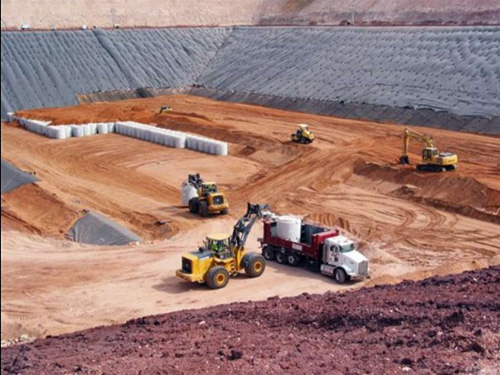
Photo: Waste Control Specialists
A quartet of environmental groups last month wrote the U.S. Nuclear Regulatory Commission in an attempt to sway the agency to dismiss Waste Control Specialists’ pursuit of temporarily storing high-level nuclear waste in Andrews County,
A quartet of environmental groups last month wrote the U.S. Nuclear Regulatory Commission in an attempt to sway the agency to dismiss Waste Control Specialists’ pursuit of temporarily storing high-level nuclear waste in Andrews County, where it currently has a facility to permanently store low-level nuclear waste, according to a recent Houston Chronicle report.
The request came on the heels of the NRC’s decision to move forward with an environmental impact study for the proposed site despite not having fully reviewed WCS’ license application. These are years-long processes that company publicist Chuck McDonald said are not unheard of to be conducted simultaneously.
"It’s going to take years for the license application to work its way through the system, and it’s going to take multiple years for the EIS process to play out. Both give the public many opportunities to participate," he said. "The sooner we start the public participation, the better."
He said it also makes sense for the NRC to allow an environmental impact study during the application review because the commission won’t grant licensure unless an environmental impact study is passed; thus, the application itself requires the study.
Environmental groups, such as Public Citizen and Sierra Club, say Congress never approved of a private company storing high-level nuclear waste despite Energy Secretary Ernest Moniz’s testimony before Congress in September that the Department of Energy believes it can do so without congressional action.
The DOE in October issued a request for information from interested private entities. WCS and its competitor, Holtec, which is pursuing high-level nuclear waste storage in New Mexico across the state line from WCS’ facility, are expected to respond to the DOE’s request.
McDonald said the funding source might require Congress’ approval and cited two ways the DOE could pay for interim storage while the government finds a place for permanent geologic storage, which could take up to 40 years. One source comes from electric bill surcharges collected for waste disposal. This fund is at $40 billion, but there could be a catch.
"Congress originally stipulated that that fund could only be used for disposal, not interim storage," McDonald said.
The second source is through the $500 million taxpayers pay per year to utility companies after the utilities sued the DOE for failing to take high-level nuclear waste, which the agency is required by law to do.
"The DOE is saying it makes more sense to use that settlement money for funding storage because it’s coming from taxpayers’ pockets," McDonald said.
He said WCS is optimistic that its Andrews facility will ultimately be granted a contract for interim high-level nuclear waste storage despite federal projects like this moving "at glacial speed."
"We have two things going for us that no one else in the country can say," he said. "First, we have an operating low-level radioactive waste disposal facility with experienced employees that do this every day. The process for interim high-level nuclear waste storage is very similar.
"Second, we have a community that is very supportive of this and understands it after 20 years and has passed a resolution of support because they know this material can be handled safely and in an environmentally appropriate fashion, and it can be a source of revenue for the county. They’re willing to entertain other radioactive waste storage options. Not many places in the U.S. can bring that to the table for the federal government, and Andrews County is unique in that aspect."
McDonald said in a Reporter-Telegram report this summer that WCS is pursing interim storage of high-level nuclear waste because there is a growing need to store the waste safely in one place while the federal government decides where to store it permanently. The DOE is required by law to take waste from utilities, but it has failed to do so. The waste from fully decommissioned nuclear power plants is scattered across the nation, and the stockpiles are growing as more nuclear plants reach the end of their useful lives, about 40 years.
Last month, the Fort Calhoun plant in Kansas shut down. Seven more are expected to cease operations through 2025, according to the Energy Information Administration. In the next 25 years, McDonald said between 50 and 60 plants would come offline — all of them without a place to permanently store waste after the Obama administration ended pursuit of Yucca Mountain in Nevada as the waste’s home.
"They say if they restarted Yucca Mountain tomorrow, it would be about 25 years before they were ready to do permanent disposal there," McDonald said, adding that it’s best to move waste to a centralized location for safety and to give the space formerly occupied by nuclear plants back to communities.
Finding a home for nuclear waste nationally is the same process Texas had to go through, McDonald said.
"The state had an obligation to take waste from low-level radioactive waste generators. The state was unable to site a facility, so it passed legislation to contract with a private entity to meet its obligation. That’s the genesis for everything that’s WCS."
As for the environmental groups that want NRC to end WCS’ application process, "there’s a little bit of irony in the noise from those groups because they’re the ones who demand an opportunity to participate, but they are protesting the fact that this participation process has now begun," he said.
Like Trevor on Facebook and follow him on Twitter at @HowdyHawes.
This document contains copyrighted material whose use has not been specifically authorized by the copyright owner. SEED Coalition is making this article available in our efforts to advance understanding of ecological sustainability, human rights, economic democracy and social justice issues. We believe that this constitutes a "fair use" of the copyrighted material as provided for in section 107 of the US Copyright Law. If you wish to use this copyrighted material for purposes of your own that go beyond "fair use", you must obtain permission from the copyright owner.
PG&E to close Diablo Canyon, California’s last nuclear power plant
June 21, 2016
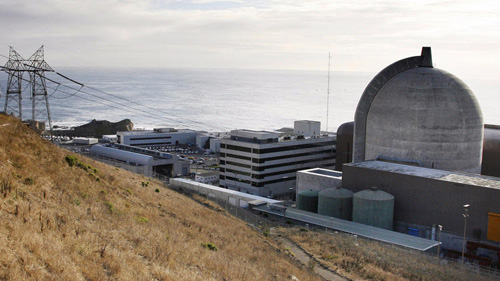
Pacific Gas & Electric’s Diablo Canyon plant near Avila Beach has California’s last operating nuclear reactors. (Michael Mariant / Associated Press)
By Ivan Penn and Samantha Masunaga
LA Times
One of California’s largest energy utilities took a bold step in the 21st century electricity revolution with an agreement to close its last operating nuclear plant and develop more solar, wind and other clean power technologies.
The decision announced Tuesday by Pacific Gas & Electric Co. to close its beleaguered Diablo Canyon nuclear plant within the next decade runs counter to the nuclear industry’s arguments that curbing carbon emissions and combating climate change require use of nuclear power, which generates the most electricity without harmful emissions.
Instead, PG&E joined with longtime adversaries such as the Friends of the Earth environmental group to craft a deal that will bring the company closer to the mandate that 50% of California’s electricity generation come from renewable energy sources by 2030.
PG&E’s agreement will close the book on the state’s history as a nuclear pioneer, but adds to its clean energy reputation. California already leads the nation by far in use of solar energy generated by rooftop panels and by sprawling power arrays in the desert.
"California is already a leader in curtailing greenhouse gases," said Peter Bradford, a former member of the U.S. Nuclear Regulatory Commission. "Now they’re saying they can go even further. That’s potentially a model for other situations."
Under the proposal, the Diablo Canyon Power Plant in San Luis Obispo County would be retired by PG&E after its current U.S. Nuclear Regulatory Commission operating licenses expire in November 2024 and August 2025.
The power produced by Diablo Canyon’s two nuclear reactors would be replaced with investment in a greenhouse-gas-free portfolio of energy efficiency, renewables and energy storage, PG&E said. The proposal is contingent on a number of regulatory actions, including approvals from the California Public Utilities Commission.
The Diablo Canyon nuclear plant, built against a seaside cliff near Avila Beach, provides 2,160 megawatts of electricity for Central and Northern California — enough to power more than 1.7 million homes.
Tuesday’s announcement comes after a long debate over the fate of the plant, which sits near several earthquake fault lines. The Hosgri Fault, located three miles from Diablo Canyon, was discovered in 1971, three years after construction of the plant began.
Diablo Canyon nuclear power plant will be shut down in 2025 after its operating licenses expire, owner Pacific Gas & Electric Co. has announced. Here’s a look at what will become of the plant, according to a recently revised plan by PG&E consultant TLG Services.
Calls to close Diablo Canyon escalated after a 2011 quake in Japan damaged two reactors at the Fukushima Daiichi nuclear power plant there, leading to dangerous radiation leaks. In the aftermath of that disaster, state and federal lawmakers called for immediate reviews of Diablo Canyon and the San Onofre nuclear plant in San Diego County, which was still in use.
The San Onofre plant was shut down for good in 2013 as a result of faulty equipment that led to a small release of radioactive steam and a heated regulatory battle over the plant’s license.
In documents submitted to the federal Nuclear Regulatory Commission as recently as last year, PG&E said Diablo Canyon can safely withstand earthquakes, tsunamis and flooding.
Daniel Hirsch, director of the program on Environmental and Nuclear Policy at UC Santa Cruz, said PG&E’s agreement was thoughtful.
"It is not simply a decision to phase out the plant, but to replace it with efficiency and renewables," he said. "So it is a very strong net gain for the environment."
As the state boosts its energy efficiency goals and plans for renewables, including solar and wind power, Hirsch said, Diablo Canyon is "getting in the way."
PG&E Chief Executive Tony Earley acknowledged the changing landscape in California, noting that energy efficiency, renewables and storage are "central to the state’s energy policy."
"As we make this transition, Diablo Canyon’s full output will no longer be required," he said. That eventually would make the nuclear plant too expensive to operate, Earley said during a conference call with reporters.
Hirsch tempered his approval with caution, saying that as long as the plant remains in operation, safety risks remain.
"Diablo really does pose a clear and present danger," he said. "If we had an earthquake larger than the plant was designed for, you could have a Fukushima-type event that could devastate a large part of California."
State senate leader Kevin de León (D-Los Angeles) echoed Hirsch by saying nuclear energy is "inherently risky, and the Diablo Canyon Power Plant is vulnerable to damage from natural disasters that could threaten the well-being of millions of Californians. This transition will make our energy sources less volatile, more cost-effective, and benefit the air we breathe."
In the mid-2000s, the nation’s utilities had anticipated a nuclear renaissance that would usher in a new age of centralized power plants. Power companies submitted proposals to the U.S. Nuclear Regulatory Commission for 31 new reactors. President George W. Bush pushed federal loan guarantees to hasten nuclear plant construction.
However, instead of a renaissance, the nuclear industry began to unravel.
Duke Energy announced in February 2013 that it would close the Crystal River, Fla., nuclear plant after a steam generator replacement project led to cracks in the concrete reactor containment building. The plant became too costly to fix.
In May 2013, Dominion Resources Inc., permanently shut down the Kewaunee nuclear plant in Wisconsin after the power company said it was no longer affordable to operate the facility.
A month later, Southern California Edison permanently closed the San Onofre plant after the determining that fixing the new but faulty steam generators would prove too expensive.

Perhaps the biggest problem for the nuclear industry was the vast amount of natural gas that became available in the United States because of fracking.
Natural gas plants now are far cheaper to build and operate than a nuclear plant. A natural gas facility runs at about 8 or 9 cents a kilowatt hour compared with twice that much for a nuclear plant.
And the push for renewable energy has turned attention to solar and wind power to help reduce emissions and combat human-caused climate change.
"The unraveling of the renaissance was not a surprise to anyone who understood the workings of the power markets," said Bradford, the former U.S. Nuclear Regulatory Commission member. He serves as an expert witness in legal proceedings across the nation.
Bradford said PG&E’s plan for Diablo Canyon shows the flaws in arguments by the nuclear industry that a clean-energy network requires nuclear.
"It’s a very tough day for people who have been advocating for massive nuclear subsidies," Bradford said.
Even after Diablo Canyon closes, Southern California will still get a small percentage of its electricity from Arizona’s Palo Verde nuclear plant. Among the owners of the 4,000 megawatt nuclear plant in the Arizona desert are Southern California Edison, the Los Angeles Department of Water and Power and the Southern California Public Power Authority, whose members include municipal power companies supplying Glendale, Pasadena, Burbank and Anaheim.
The impending closure of Diablo Canyon would leave just one nuclear plant on the West Coast, the Columbia Generating Station, about 200 miles outside of Seattle.
To craft Tuesday’s proposal, PG&E worked with the International Brotherhood of Electrical Workers Local 1245, the Coalition of California Utility Employees, the Natural Resources Defense Council, Environment California, Friends of the Earth and the Alliance for Nuclear Responsibility.
ivan.penn(at)latimes.com
samantha.masunaga(at)latimes.com
This document contains copyrighted material whose use has not been specifically authorized by the copyright owner. SEED Coalition is making this article available in our efforts to advance understanding of ecological sustainability, human rights, economic democracy and social justice issues. We believe that this constitutes a "fair use" of the copyrighted material as provided for in section 107 of the US Copyright Law. If you wish to use this copyrighted material for purposes of your own that go beyond "fair use", you must obtain permission from the copyright owner.
Editorial The solution to storing San Onofre’s spent nuclear fuel
November 30, 2015
The Los Angeles Times Editorial Board
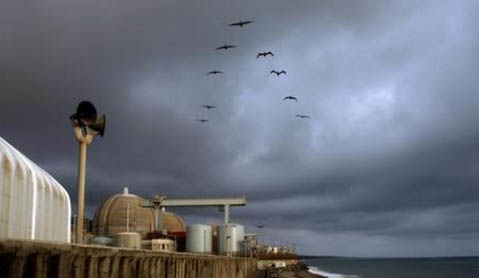
Pelicans fly in formation over the decommissioned
San Onofre Nuclear Generating Station
Tuesday, March 25, 2014. (Los Angeles Times)
No one really likes the idea of storing spent nuclear fuel rods at the edge of the mighty Pacific Ocean, even if they are sealed in stainless steel canisters, encased in concrete and partially buried. What would happen to the millions of people living within 50 miles, or the Pacific’s marine life, if there were a leak or an accident? What would happen if California were hit with a tsunami like the one that caused the Fukushima Daiichi nuclear power plant disaster in Japan in 2011?
This is the sort of fearful speculation that has emerged since Southern California Edison revealed its plan to store spent fuel rods from the decommissioned San Onofre Nuclear Generating Station on the power plant’s grounds rather than at a federally approved nuclear waste disposal site. The reason: No such facility exists. You can thank the federal government, and Sen. Harry Reid (D-Nev.) in particular, for that.
This nation approved and built nuclear plants without ever providing a safe place for their waste to be stored.
This nation approved and built nuclear plants without ever providing a safe place for their waste to be stored, knowing all along that it would remain lethally radioactive for thousands of years. Congress settled on a site for a national nuclear waste repository — Yucca Mountain, deep in the wilderness of Nevada — but the project stalled in 2009 after the Obama administration formally opposed it. That fulfilled a promise candidate Barack Obama had made to Reid and voters in Nevada, a key swing state.
Some members of Congress are pushing to get funding as early as next year to test out privately-run temporary storage facilities for spent fuel rods. But even if lawmakers fund the projects now, it would take a decade or longer to get the sites approved and built.
This leaves no real option for San Onofre other than nuclear beach bunkers. The California Coastal Commission came to the same conclusion last month when it approved Edison’s plan to store 75 canisters on site until an off-site waste station is built. San Onofre has been storing its spent fuel rods on site without issue for decades.
Residents of Orange and San Diego counties have long had an uneasy relationship with the beachfront nuclear plant, which is perched near a coastal fault line. So community activists and environmentalists celebrated when San Onofre was officially decommissioned in 2013 after equipment troubles shut down its last two reactors.
Now that the reactors are turned off, however, the public health threat is dramatically reduced because there’s no opportunity for a catastrophic meltdown. The waste storage containers are built to withstand tsunamis and earthquakes. Still, a handful of activists aren’t satisfied and have sued to reverse the Coastal Commission’s approval. They would prefer that the spent fuel rods be packed up and shipped via truck to the Palo Verde nuclear plant in Tonopah, Ariz., in which Edison has a minority stake.
But Palo Verde’s license from the Nuclear Regulatory Commission allows the plant to store only its own spent rods, not those from other plants. Also, the Palo Verde plant is on the outskirts of Phoenix, whose residents would hardly welcome the idea. And then there’s the peril of sending trucks loaded with nuclear waste through one of the nation’s most congested freeway systems.
If a judge puts Edison’s plans on hold, it could leave the coast more vulnerable by delaying construction of the steel canisters and concrete bunkers. Right now, the spent fuel rods are being kept in cooling pools, which were intended for only temporary storage. Dry-cask storage provides more long-term protection against such risks as rising oceans and terrorism. It’s safer to pack them into canisters than to let them linger in the pools while the litigation plays out.
If San Onofre opponents want to hasten the departure of the fuel rods, they should instead lobby federal lawmakers to open Yucca Mountain. They could also throw their support behind legislation by Sen. Dianne Feinstein (D-Calif.) and other senators that would lay out a comprehensive plan for storing waste from the country’s decommissioned nuclear energy plants. The bill’s prospects are unclear, as it has yet to be heard in the Senate Natural Resources Committee.
In Congress, the safe disposal of nuclear waste apparently doesn’t rank as a priority. That won’t change until enough concerned Americans demand better solutions to the problems posed by reactors’ highly radioactive trash.
This document contains copyrighted material whose use has not been specifically authorized by the copyright owner. SEED Coalition is making this article available in our efforts to advance understanding of ecological sustainability, human rights, economic democracy and social justice issues. We believe that this constitutes a "fair use" of the copyrighted material as provided for in section 107 of the US Copyright Law. If you wish to use this copyrighted material for purposes of your own that go beyond "fair use", you must obtain permission from the copyright owner.
Entergy Announces Second Nuclear Plant Closure in Less Than a Month
November 2, 2015
Associated Press
SCRIBA, N.Y. — Entergy Corp. says it plans to close the James A. FitzPatrick nuclear power plant on Lake Ontario.
The company announced the move Monday and says the decision is based on the deteriorating economics of the facility — reduced plant revenues due to low natural gas prices, poor market design and high operational costs.
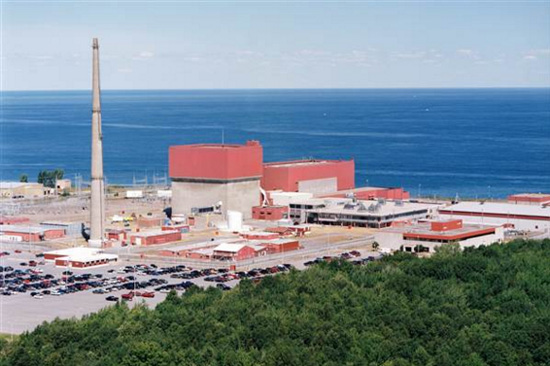
The James A. FitzPatrick nuclear power plant, located in Scriba, New York, is to be closed. U.S. Nuclear Regulatory Commission
The company says the facility, which has an annual payroll of $74 million and pays more than $17 million in taxes, is losing around $60 million annually.
Barring intervention by state officials, the 850-megawatt facility in Scriba, New York, will shut down in late 2016 or early 2017 and begin laying off its 615 employees.
FitzPatrick began generating electricity in 1975 and produces enough electricity to power more than 800,000 homes. Scriba is about 40 miles north of Syracuse.
It is the second closure of a U.S. nuclear plant announced by Entergy in less than a month.
On Oct. 13, the company said it would shut the Pilgrim Nuclear Power Station in Plymouth, Massachusetts, by June 2019.
A statement announcing the closure of the only commercial nuclear plant in the state cited “poor market conditions, reduced revenues and increased operational costs.”
This document contains copyrighted material whose use has not been specifically authorized by the copyright owner. SEED Coalition is making this article available in our efforts to advance understanding of ecological sustainability, human rights, economic democracy and social justice issues. We believe that this constitutes a "fair use" of the copyrighted material as provided for in section 107 of the US Copyright Law. If you wish to use this copyrighted material for purposes of your own that go beyond "fair use", you must obtain permission from the copyright owner.
